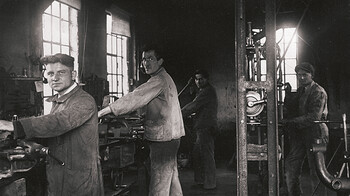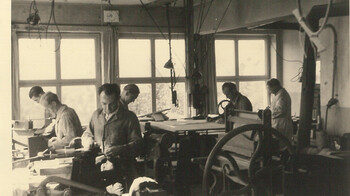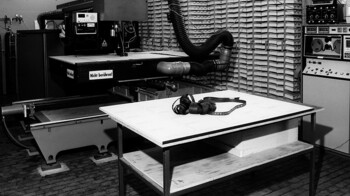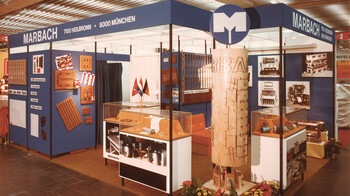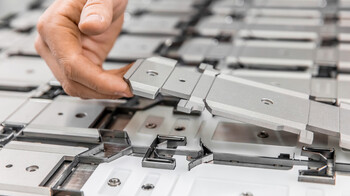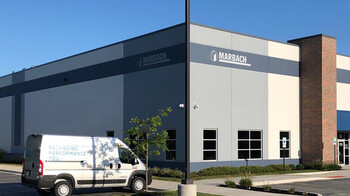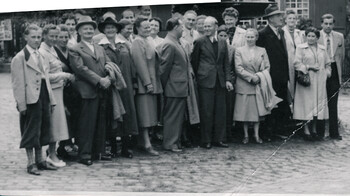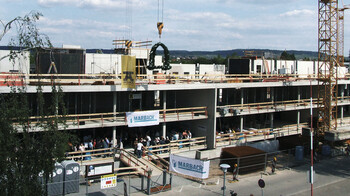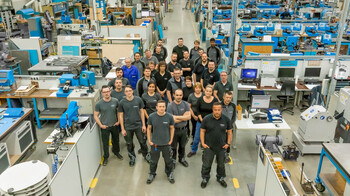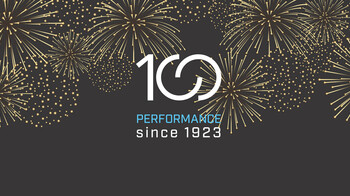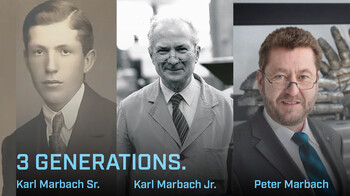100 years of Marbach. From a 3-man workshop to world market leader.
In 1923, the Marbach company started as a 3-man workshop in Heilbronn, Baden-Württemberg. 100 years later, the small craftsman business has become an internationally active world market leader. Today, the Marbach Group with its 1,600 employees worldwide is an important partner of the global packaging industry.
Such a long company history is not self-evident – in Germany only a bit more than 1% of the companies reach 100 years. The fact that Marbach has managed this is due to many different factors.
In the following, we would like to take you on a journey into the past. We will stop at the most important developments and events that have made the Marbach Group what it is today: a world market leader in the production of tools for the packaging industry.
1923 - 1927.
The founding years.
On July 16, 1923, Karl Marbach Senior founded a mechanical workshop in Heilbronn together with two partners. The company's most important products were manual top knives for the regional shoe industry. The company was founded in the crisis years after the First World War and business already had to be suspended in the first year. In 1924 Karl Marbach Senior re-started the business, this time on his own, and moved the workshop to Fügerstrasse. However, as a result of the world economic crisis, there were fewer and fewer customers from the shoe industry. As fate would have it, at that time the advertising material factory Nupnau in Heilbronn was looking for a regional supplier for steel rule dies. Karl Marbach Senior therefore, started from then on to focus on the production of steel rule dies. This decision would prove to be a very farsighted one.
1939 - 1945.
The War Years.
A short time later, another world crisis began with the Second World War. In addition to steel rule dies for the advertising industry, Marbach also produced tools for the sealing industry during this time. This paid off: because tools for the production of seals for engines, transmissions and pumps were urgently needed. In order to maintain the family business, Karl Marbach Junior ran errands for his parents during the war years. He also trained as a mechanic in his parents' company. On December 4, 1944, the company building in Fügerstraße was partially hit and damaged during an air raid and production was temporarily relocated to Unterheinriet. However, this temporary location was also destroyed in 1945. From the remains of the company, a locksmith's workshop was temporarily set up in an old, disused cattle shed.
After the war, the business was moved back to Heilbronn. There, the company had to start from scratch again. The newly started production initially included steel rule dies for the engine and sealing industry, but increasingly also cutting-dies for the advertising and packaging industry. In 1955, with Karl Marbach Junior, the second generation joined the company and with him came many new ideas.
In 1957, the first expansion of the Marbach company was the setting up of its own department for thermoforming tool making, which finally became legally independent almost 30 years later.
1972 – a major milestone.
the use of lasers in die-cutting technology.
In 1969, Karl Marbach Junior first heard about a revolutionary new cutting technology. At a symposium in England, he met S. Ray Miller Junior, President of Atlas Steel Rule Dies Inc. from Elkhart (USA). Since 1968, this company had been the first in the world to use CO2 lasers in cutting-die production and Miller's talk was on the subject of "Cutting wood with light". The two remained in contact, with Marbach finally investing in the first CNC-controlled CO2 laser cutting system for cutting-die production in Europe in 1972. The introduction of this technology was a quantum leap in diemaking and brought Marbach to the fore as a pioneer in the market leadership in Europe. In the following years the company could also consolidate its position as an innovation leader. Thus, the use of laser technology for the production of cutting-dies was not only a major milestone for the Marbach Group and the entire diemaking industry in Europe, but became the corner stone of the company's future success.
Since 1977 – a successful exhibitor.
The trade fairs.
Up to the present day, Marbach has been a frequent exhibitor at trade fairs worldwide. By 1966 Karl Marbach Jr. had already laid the groundwork for these appearances at many large, but also smaller, trade fairs. This began when he participated for the first time in a trade show: as a visitor at the interpack in Düsseldorf. Eleven years later, Karl Marbach was again at an exhibition in Düsseldorf – but this time as an exhibitor. The "drupa 1977" was a great success and appearances like this at the leading trade show in the die-cutting technology sector, would become an important part of the business from then on. Over the years, countless exhibitions have been added to the company's worldwide itinerary: from the K trade fair in Düsseldorf, which is the most important exhibition for Marbach Werkzeugbau (thermoforming tools), to FachPack but also including international exhibitions such as the IADD Odyssey in the USA or Chinaprint in China. Sometimes single 'lone fighters' have represented the company in far away places, sometimes exhibition teams were available at the stands to welcome visitors in countless languages. Each and every one of them have contributed to the company's continuing success with their commitment and persuasive skills, and will continue to do so in the future.
Technologies, innovations and patents.
Marbach sets market standards.
Over the years, Marbach has introduced numerous technologies and innovations to the market, many of which remain standards in the industry today. These include mpower, marbastrip as well as the crease-plate-die. Marbach is known in the market as an innovative company that regularly applies for patents and continues to set market standards. However, not only in-house developments and patents have made Marbach the innovation leader that it is today, the company has always been interested in new technologies and managed to employ many innovations from other industries for its own benefit. For example, Marbach took over the license for the production of rillma matrices in 1967. With rillma, Marbach was able to offer its customers not only the cutting-die but also the matching counter plate, thus giving them the opportunity to produce folding cartons with unprecedented accuracy.
The list of changes is long and getting longer all the time. With CONNECT|M technology, Marbach is gearing up for Industry 4.0 in both die-cutting technology and toolmaking. It will be fascinating to see which innovations the company will develop in the future. To date, Marbach has registered more than 100 patents and industrial designs with the patent office.
Since 1984 – Expansion and internationalization.
The Marbach network.
The fact that Marbach would one day become a company group with 1,600 employees and many trading partners, agents, joint ventures and representatives worldwide, has been mainly due to the excellent network that the Marbach family has built up over many decades. Today, Marbach consists of more than 20 production and sales subsidiaries in addition to joint ventures and franchising partners. Internationalization began in 1984 with participation in the company Arden Dies in Stockport (England). In the following decades, both subsidiaries and joint ventures followed in countries such as France, Spain, Egypt, and in Eastern Europe, as well as sales offices and franchise partners in other countries such as Russia, Colombia, and the United Arab Emirates. Alone since 2012, Marbach has opened branches in the USA, Mexico, China and Malaysia.
100 years marbach.
The anniversaries.
In July 2023, the Marbach Group will turn 100, which means 100 years of innovations, performance and tooling technology par excellence. But of course, this has not been the first anniversary of the company. The company celebrated its 25th anniversary with its employees in July 1948 in the living room of the Marbach family home. 25 years later – at the company's 50th anniversary – by far not all of the meanwhile 130 employees could fit into the family's living room. The Marbach company celebrated its 50th anniversary with a ceremony in the Heilbronn House of Crafts and Trades in July 1973. The festivities for the 75th anniversary of the Marbach Group in July 1998 were even bigger: the celebration took place in the Heilbronn Harmonie, which was able to fit in more than 500 employees. Also on the occasion of the 100th anniversary, the company will express its thanks to its employees by throwing a big party.
More space and modern working.
The new buildings.
The Marbach Group has been constantly growing. Over the years, this growth has led to repeatedly cramped conditions in its existing buildings and has meant new buildings were needed. This began with the reconstruction of the building in Heilbronn's Fügerstraße after the Second World War. After that, new constructions took place several times at the current location. Beginning in 1962 new buildings followed in 1976, 2007 and 2014. Additionally new extensions were added over the years and an important addition in 2017 gave the growing company the space it needed. But it was not only in Heilbronn that investments have been made – there have been various new buildings added in Poland, such as in Tarnowsky Gory in 2009 and 2021 and in Kielce in 2016. The company has been continuously investing in its sites for most of its 100 years. Modern buildings and technologies are a success factor in the future orientation of the company and contribute to its goal of more sustainability.
On the way to becoming the world market leader.
successes and employee development.
On its journey from a craftsman's business to a world market leader, Marbach has been able to celebrate many small and large successes. They have all played their part in making the company so successful today. After the 3-man business beginning –becoming even temporarily a 1-man business in the 1920s – Marbach was also able to experience the post-war economic miracle and could expand the business in 1957 with an own tool making department. Already in 1963, the old building had become too small for the approximately 40 employees, and then, in the 1970s, the first self-service stores started. The Heilbronn-based company Knorr had a great need for packaging, which triggered a boom in the entire packaging industry. By 1976, Marbach was already employing 200 employees.
The introduction of innovations in various areas of the business increased Marbach's productivity enormously. This continued to have an impact on the company's growth. In the mid-1980s, Marbach also began to expand, growing into an international group of companies. The success of the Marbach Group could now no longer be overlooked. Karl Marbach had therefore managed to create a corporate group out of his father's craftsman business. When he celebrated his 80th birthday in 2007, Marbach employed about 1,000 people worldwide. In 2008, there were already 1,100 employees. Marbach continued to grow in the 2010s. The number of employees rose further from 1,300 in 2016 to 1,600 today. The growth did not only come from the German businesses, but also from foreign locations. Marbach has further contributed to the globalization dynamic by opening new subsidiaries.
Challenges make us strong.
New opportunities.
In the 100 years of the company's history, however, there have not only been successes, but also many challenges that needed to be mastered in order to be able to survive. For example, the company was on the verge of going out of business in the first year, when Karl Marbach Senior suspended the company's business operations. During the Second World War, the company was partly destroyed and had to be rebuilt. If Karl Marbach Junior had not quit his job at IBM to join the parental company in 1955, or if the investment in the laser system had turned out to be a flop in 1972, the company's history might well have ended there. Marbach has survived all subsequent economic crises and even a pandemic. But despite all these challenges, Marbach can look back over 100 years and also look forward to a bright future.
Three generations.
The family business.
The secret of Marbach's success is its connection to the Marbach family and thus to the people who founded, expanded and made it a sucessful company. Their endless commitment and inventiveness have ensured the continuity of the company even in times of crisis. They are the family behind the business, and for three generations have done everything in their power to ensure that the company remains successful.
All 3 generations – from Karl Marbach Senior and Karl Marbach Junior to today's managing partner Peter Marbach – have all one thing in common: foresight to recognize and understand the changing times and to act accordingly. Possessing these qualities, three generations of the Marbach family have turned the company from a small craftsman's business into what it is today: a world market leader in the production of tools for the packaging industry.

